The Eurocom Sky X7C (Clevo P775TM1-G) Gaming Laptop Review: True Desktop Replacement
by Brett Howse on August 5, 2019 8:00 AM ESTBattery Life
The Eurocom Sky X7C comes equipped with an 80 Wh battery, which is quite reasonable considering it’s not the type of device that should really be expected to be run on battery for any length of time. The battery in a desktop replacement such as this is really a glorified UPS, and Eurocom even calls it as much in their mobile server versions of their notebooks.
Light Battery

Battery life was somewhat better than expected, coming in at close to three hours of runtime with the display set to 200 nits. Considering the desktop processor and no NVIDIA Optimus support, that’s quite good.
Web Battery
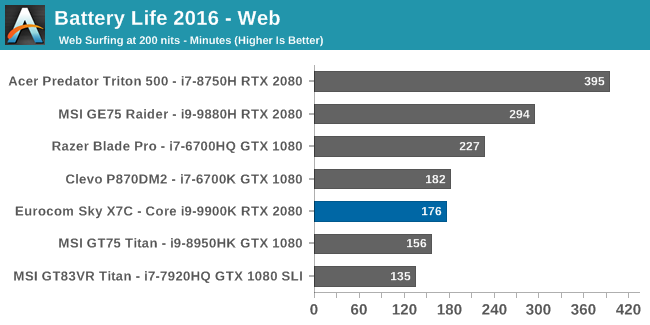
This test has a more demanding workload than our light test, but on large gaming laptops the base power draw is generally high enough to mask the extra CPU power required, and that is the case here with the Eurocom running four minutes longer than the light test. It’s still a reasonable result though considering the class of components inside.
Movie Playback
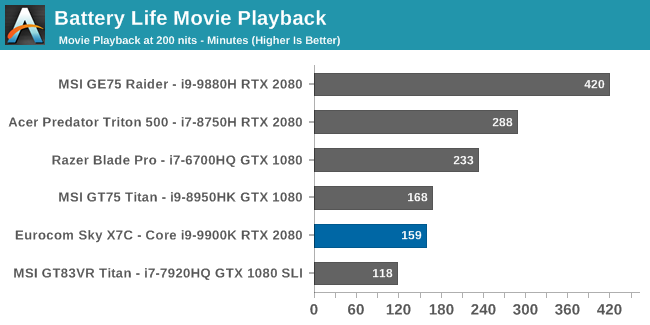
Ultrabooks can excel at media playback because the video decode is handed off to fixed function hardware in the integrated graphics, which is extremely power efficient. That same thing happens here, except it’s handed off to a power-hungry RTX 2080, and as such the movie playback is shorter than the previous two tests.
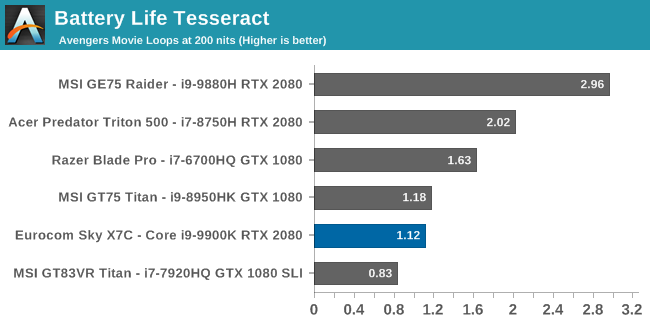
The Tesseract score is the movie playback time divided by the length of The Avengers, and you can barely make it through one sitting of this movie before the power runs out.
Normalized Results
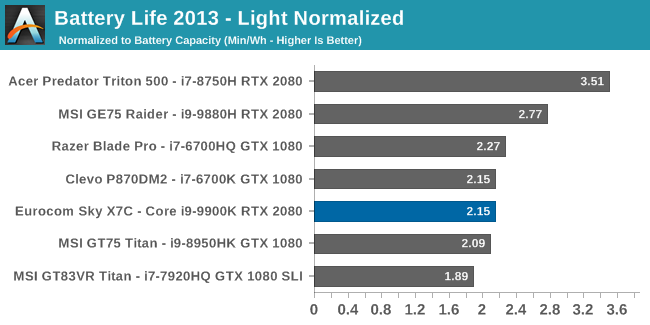

Removing the battery capacity from the runtime allows us to get a glimpse at efficiency, and you can instantly see what a difference NVIDIA’s Optimus makes here, as both the Acer Predator Triton 500 and MSI GE75 Raider both offer Optimus so the RTX 2080 can be powered down. The other notebooks have the dGPU connected directly to the display, limiting efficiency.
Battery Conclusions
On a system such as this, the battery life is a secondary goal at best, and the results coincide with this. The maximum battery size allowed on an airplane is under 100 Wh, meaning that is the practical upper limit for battery size. The Eurocom Sky X7C actually offers an 80 Wh battery, which is really larger than it needs to be for this class of machine where it is going to be plugged in almost all the time, so the battery life is actually quite good considering.
Charging
Eurocom offers a standard 330-Watt AC Adapter with the Sky X7C, which is easily sufficient to power the system even with the Core i9-9900K and RTX 2080 at stock speeds. However they do offer a 780-Watt adapter as well, which they shipped out with this system, and it is literally a small-form factor desktop PSU with a custom connector to go into the laptop. The PSU offers a digital readout of amperage, voltage, watts, and temperature, and includes active cooling as you’d expect on a PSU this large.
If you are into overclocking, you may want to upgrade to this unit, since the stock 330-Watt adapter is going to run into power limits if you do try overlocking. The CPU can easily draw 150-Watts stock, and the GPU would be around the same. It’s unlikely you’d ever need the full 780 Watts, but it certainly is impressive, and the digital display is very informative compared to a black power brick like you’d see on most notebooks.
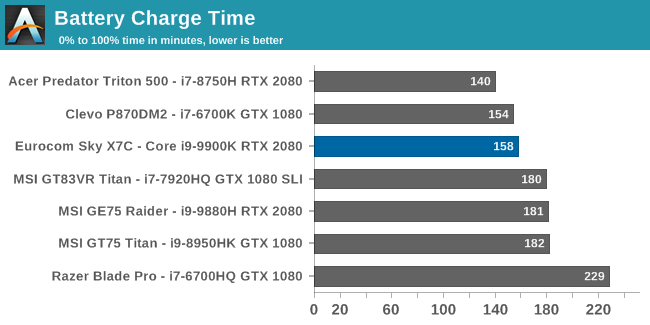
That doesn’t really impact the charge rate though, since the battery charging is limited to protect the battery life, and as such the time to charge this notebook is about the same amount of time as you can use it on battery.


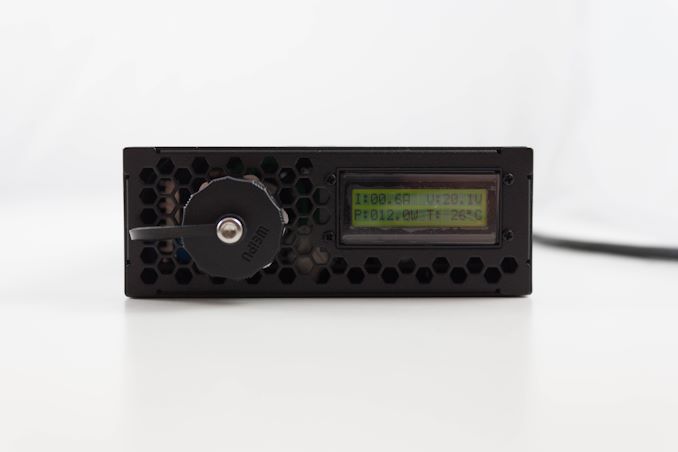








46 Comments
View All Comments
p1esk - Monday, August 5, 2019 - link
I love the option of 1440p at 120Hz! Hope to see it in normal laptops (perhaps new MBPs can lead the way to improved refresh rates?)HollyDOL - Monday, August 5, 2019 - link
Since the article title talks about 'true desktop replacement', could we get price and performance comparison to desktop with "same" parts? ie. DDR4-3000 + 9900K + RTX 2080...Brett Howse - Monday, August 5, 2019 - link
Our GPU bench is currently an i9-9900K as well. As a comparison I got 116 FPS on Shadow of the Tomb Raider, and Ryan got 114.6 with the desktop version, so the performance seems similar. Unfortunately we don't have a lot of overlap on our tests though because Ryan is able to keep GPUs and benchmark them on new suites whereas laptops have to go back to the manufacturers so I don't rotate the tests as heavily since every time I add a new test it starts out with zero results to compare against.Is there a particular title you'd like to see compared against other than Shadow of the Tomb Raider?
HollyDOL - Tuesday, August 6, 2019 - link
nice, thanks...Compile Chromium (time) test would be nice...
or in general anything that puts the machine under high sustained stress for longer period (45mins+)...
craz8 - Monday, August 5, 2019 - link
I have one of these laptops - a Sager branded one.It really is quite heavy, and the 330W power brick is equally beefy - I selected the RTX 2070 to avoid needing double power bricks. I do use this on my lap, but the power plug at the back falls out a lot in this configuration. It's not a very secure connection. Since it's at the back, the only way to notice is that suddenly the CPU is running at 1.3Ghz instead of 4+
I almost always run this in Quiet mode, as the fans are almost silent in this mode. When I'm stressing the machine, the CPU clocks down to about 3.4-3.6 Ghz, which is still good enough for the work I do on it. If I run in performance mode, the things I run go a little faster, but the fan noise is not worth the extra speed.
There really isn't enough cooling for Nvme drives. Even small amounts of writing to them immediately pushes the temps to 90+, and there's no room for extra heatsinks to help with this.
I have the 4K screen, which seems pretty good, but if you dual boot into a Linux OS, the bootloader screen is hilariously small, and some versions of Linux have poor scaling options
I mostly use this on my desk, and it (or Windows 10) really doesn't like my CalDigital TB3 dock. Luckily, everything plugs into the chassis (unlike recent Apple hardware)
I don't play games on this, so barely use the GPU (RTX 2070). I'd love to have options to push more power and cooling to the CPU whilst scaling them back to the GPU without having to poke at the values manually.
Overall, I like mine, but it does have quirks.
Alistair - Monday, August 5, 2019 - link
I think you'd be much better off with a (I hate to say it) nVidia creator laptop, or a 9880H/9980HK laptop with a 120/144hz Gsync IPS screen. We need a comparison with Clevo of the MSI Stealth and Raider and Titan.https://www.newegg.com/matte-black-with-gold-diamo...
Brahman05 - Monday, August 5, 2019 - link
I have sager's version of the x9e2 with a 7700k and 1080sli and the same 1440p panel, and the panel is both one of the best and worst parts in the thing. One thing not mentioned in this article is the gtg does not really support the refresh rate, but by reporting a 120hz refresh it at least still cuts down on input lag. I really have no complaints though. When I got it I had a mobile lifestyle and had the money for it, my only two real gripes are ZEN and RTx. Not 3 months after I got the thing AMD goes and makes 8c16t a thing and even if the architecture is pretry much the same from the 6700k to the 9900k the productivity of the same class chip is now double. And with RTX going to NVLink for an sli bridge Nvidia has axed mobile sli due to the complexity involved in producing that type of connector. So this X7c is really the way to go anymore. Damn you progress!LsRamAir - Monday, August 5, 2019 - link
No Overclocking detail... bahhhh! Pushing these DTRs to the max that their cooling allows for is what at least half of their buyers do... Next time, yes please! (Especially in the wake of similarly spec'd DTR machines burning out under mild OC's, which SHOULD NOT HAPPEN, it would be nice to know if this SKY is also part of the bad choices group.)peteraustin - Tuesday, August 6, 2019 - link
Amazing article https://www.anandtech.com/ you should definitely read it in your spare timehennes - Tuesday, August 6, 2019 - link
I recently got this laptop as a replacement for a 10 1/2-year-old laptop. I wanted a full-sized keyboard, which means 17” or larger. Potable means 17” really it the limit. And 17” is perfect for 2k screens.The Sky X7 was one of the few which offered that and it had all my desired other connectivity (multiple NVME, multiple DP out, a few fast USB ports, thunderbolt, …
What really was surprising is how few other there are. Many with low res displays (1920x1080) which makes sense for gaming. Some with 4K displays future proof but quite small on a 17” display.
That made the X7C almost the only sensible choice.
And from an engineering view the thicker than average body was also very attractive. As were the looks. Form over function simply looks good, while designed stuff tend to look odd and twisted to me.
The only thing it lacks for me is more battery capacity. Lugging the large charger around is not fun and two battery slots (or 2x 80) for airplane use would have been my choice if it was offered.